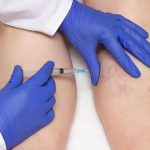Sclerotherapy Treatment
Sclerotherapy Treatment
A medical procedure used to eliminate spider veins in the legs.
Sclerotherapy is often done for cosmetic purposes — to improve the appearance of spider veins.
Sclerotherapy involves injecting a solution directly into the vein. The sclerotherapy solution causes the vein to scar, forcing blood to reroute through healthier veins. The collapsed vein is reabsorbed into local tissue and eventually fades.
After sclerotherapy, treated veins tend to fade within a few weeks, although occasionally it may take a month or more to see the full results. In some instances, several sclerotherapy treatments may be needed.
What you can expect before procedure
Before the procedure a detailed assessment is made
- Past and present medical history
- Physical examination
- Evaluate the involved veins
- Check for any underlying blood vessel disease
- Previous treatment for varicose veins and the results of the treatment
If you take aspirin, ibuprofen, naproxen, or blood thinners, you must stop taking the medication one week before the procedure, to reduce the chances of bleeding.
Results after the procedure
You can usually expect to see definitive results in three to six weeks. Larger veins may require three to four months. However, multiple treatments may be needed to achieve the results you want.
Veins that respond to treatment generally don’t come back, but new veins may appear.
A review appointment will be made 2 weeks after treatment.
A follow-up visit 6 weeks after the procedure will be made to determine how well the procedure worked and if you need more sessions. Generally, you need to wait about six weeks before undergoing another sclerotherapy session.
30 minutes estimated
None
Immediately estimated
24 hours estimated
Course of approx. 4-6 peels is recommended for optimum results
Will see results after first peel, best results after full course of peels *
6-12 Months *
Skin irritation can occur up to 24 hours *
Treatment Pricing

Sclerotherapy Treatment
£225
£225 for the first session | £200 thereafter
During the procedure
For the procedure, you’ll lie on your back with your legs slightly elevated, no anaesthesia is required and generally takes less than an hour to complete.
After cleansing the area with alcohol, a fine needle will be used to slowly insert a solution into the appropriate vein.
Some people experience minor stinging or cramps when the needle is inserted into the vein. Once the needle is withdrawn a compression is applied and massaging of the area to keep blood out of the injected vessel and disperse the solution. The number of injections depends on the number and size of veins being treated.
After the procedure
You’ll be able to get up and walk around soon after the procedure. Walking and moving your legs are important to prevent the formation of blood clots.
You’ll be asked to wear compression stockings or bandages fortwo weeks to maintain compression on the treated veins.
Normal activities can be resumed on the same day, avoid strenuous exercise for two weeks after the procedure.
You will need to avoid sun exposure to the treated areas during that time. The inflammation caused by the injections combined with sun exposure can lead to dark spots on your skin, especially if you already have a dark skin tone. Avoid flying for 4 weeks and no leg waxing for 6 weeks.
Possible complications
- Bruising
- Swelling
- Tenderness
- Hyperpigmentation
- Itching
- Matting
- No immediate improvement
Rare Complications
- Allergic reaction
- Skin necrosis
- Migraine
- Phlebitis
- DVT
Before & After















Frequently Asked Questions
Most clients use a skin peel to improve the appearance of their facial skin, but we can also administer peels to your neck, chest, back and hands
No, although you may experience a hot, itchy sensation once the solution is on your skin. This is completely normal, and should subside quickly.
No. It is not recommended for anyone with active skin infections, skin allergies, facial skin cancer, pregnancy or breastfeeding, recent use of Roaccutane (within 6 months of use ) and retinoid. *A full list of side effects, cautions and contraindications will be discussed at face to face consultation.
The most common side effects include redness and irritation and a low risk of scarring and infection. Post inflammatory pigmentation can occur however more likely in those with darker skin. The potential side effects of a glycolic acid peel depend on the depth of the peel and your skin. After a light or medium peel the skin may just feel tight and have some mild redness which usually subsides within 24 hours.
Glycolic peels have no recovery time and you will be able to resume your daily routine almost immediately
A course of 4 – 6 treatments at 1 weekly intervals are recommended for optimum results.
- Deep wrinkles
- Deep folds
- Capillaries or facial veins
